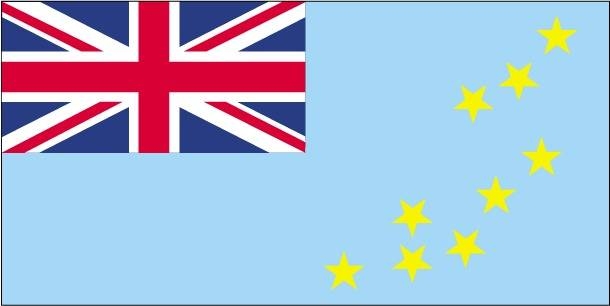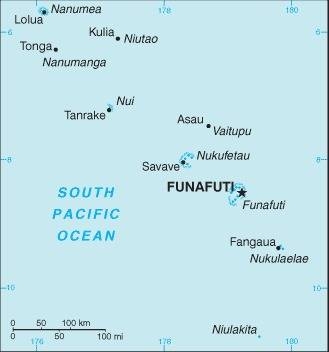Country Summary




Introduction
Background
In 1974, ethnic differences within the British colony of the Gilbert and Ellice Islands caused the Polynesians of the Ellice Islands to vote for separation from the Micronesians of the Gilbert Islands. The following year, the Ellice Islands became the separate British colony of Tuvalu. Independence was granted in 1978.
Geography
Area
total: 26 sq km
land: 26 sq km
water: 0 sq km
Climate
tropical; moderated by easterly trade winds (March to November); westerly gales and heavy rain (November to March)
Natural resources
fish, coconut (copra)
People and Society
Population
11,544 (2022 est.)
Ethnic groups
Tuvaluan 97%, Tuvaluan/I-Kiribati 1.6%, Tuvaluan/other 0.8%, other 0.6% (2017 est.)
Languages
Tuvaluan (official), English (official), Samoan, Kiribati (on the island of Nui)
Religions
Protestant 92.7% (Congregational Christian Church of Tuvalu 85.9%, Brethren 2.8%, Seventh Day Adventist 2.5%, Assemblies of God 1.5%), Baha'i 1.5%, Jehovah's Witness 1.5%, other 3.9%, none or refused 0.4% (2017 est.)
Population growth rate
0.83% (2022 est.)
Government
Government type
parliamentary democracy under a constitutional monarchy; a Commonwealth realm
Capital
name: Funafuti; note - the capital is an atoll of some 29 islets; administrative offices are in Vaiaku Village on Fongafale Islet
Executive branch
chief of state: King CHARLES III (since 8 September 2022); represented by Governor General Tofiga Vaevalu FALANI (since 29 August 2021)
head of government: Prime Minister Kausea NATANO (since 19 September 2019)
Legislative branch
description: unicameral House of Assembly or Fale I Fono (16 seats; members directly elected in single- and multi-seat constituencies by simple majority vote to serve 4-year terms)
Economy
Economic overview
upper middle-income but very fragile Pacific island economy; currency pegged to Australian dollar; public revenues from international aid, fishing licenses, and national trust fund; pursuing Te Kakeega sustainable development; significant remittances
Real GDP (purchasing power parity)
$50 million (2020 est.)
Real GDP per capita
$4,400 (2020 est.)
Agricultural products
coconuts, vegetables, tropical fruit, bananas, roots/tubers nes, pork, poultry, eggs, pig fat, pig offals
Industries
fishing
Exports
$10 million (2019 est.)
Exports - partners
Thailand 50%, Indonesia 40% (2019)
Exports - commodities
fish, ships, coins, metal-clad products, electrical power accessories (2019)
Imports
$70 million (2019 est.)
Imports - partners
China 32%, Japan 29%, Fiji 23%, New Zealand 6% (2019)
Imports - commodities
refined petroleum, fishing ships, tug boats, other ships, iron structures (2019)
Exchange rates
Tuvaluan dollars or Australian dollars (AUD) per US dollar -
Page last updated: Monday, September 12, 2022
